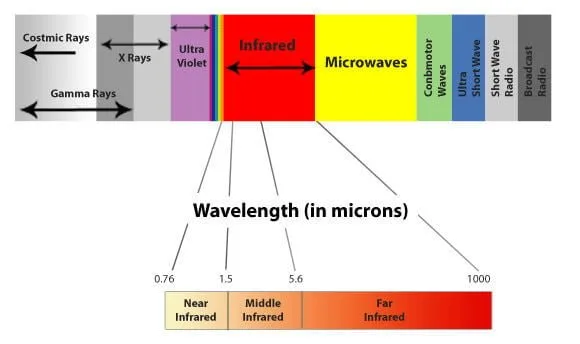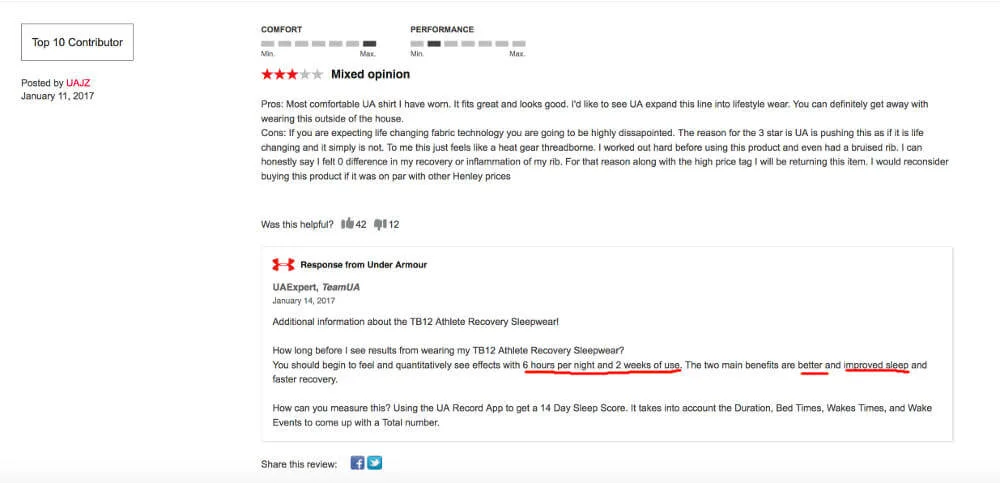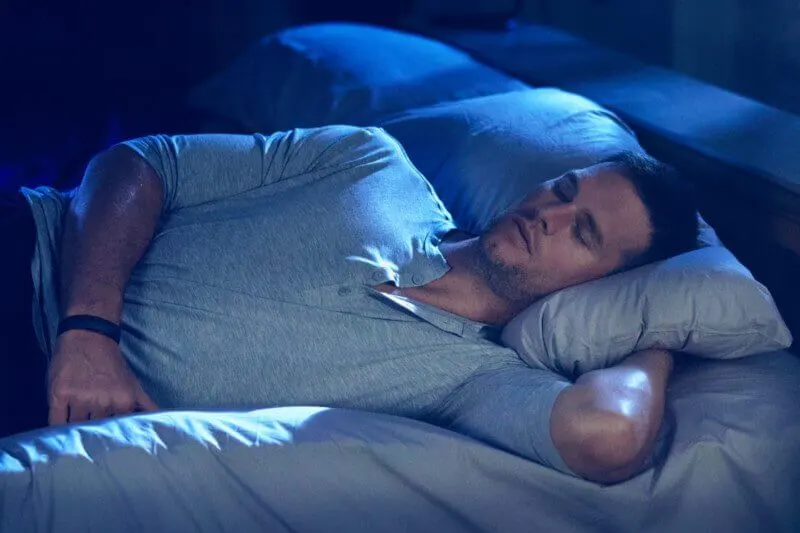Under Armour’s line of “Athlete Recovery Sleepwear” appeared on my radar today when a colleague asked me what I thought of the product.
I like Under Armour as a brand so I was curious to take a look at the far infrared technology used in the pajamas as well as the marketing claims behind the product.
According to the company website, the sleepwear is NFL football superstar “Tom Brady’s secret to recovery” with sleep being a “critical piece to sustaining his peak performance.”
So the hook is “Wear athlete recovery sleepwear. Rest. Win. Repeat.”
Heck, I want to be like Tom too, but at $200 USD for a top and bottom, does the sleepwear live up to the hype?
With that in mind, the objective of this article is to:
- discuss far infrared technology
- review the far infrared research
- compare the sleepwear marketing claims to the science
- provide an interpretation and summary
What is far infrared energy?
Before we talk about the sleepwear, what the heck is far infrared (FIR) energy anyway?
First, it is important to understand that we are surrounded by natural electromagnetic radiation at all times.
It might sound scary and conjure up images of nuclear reactors, but electromagnetic energy simply refers to different types of energy released into space by stars and planets like the sun (solar radiation) and Earth (terrestrial radiation).
There are different types of electromagnetic radiation, including infrared energy:
- Radio waves
- TV waves
- Radar waves
- Infrared radiation (heat)
- Visible light
- Ultraviolet light (wear your sunscreen!)
- X-rays (like at the hospital)
- Short waves
- Microwaves (i.e., microwave oven)
- Gamma rays
In the image below, you can see there is an infrared spectrum which can be further subdivided into three regions:
- near infrared
- middle infrared
- far infrared

Great. So what? How does this relate to Tom’s $200 PJs?
Far infrared research and applications
Under Armour lists on their website a single reference to an “NIH independent study on the benefits of Far Infrared energy on recovery.”
When I clicked on the link I found that it was not an “independent study” on their finished sleepwear product, but was just a general review paper on biological applications of far infrared technology.
In the review, Harvard scientists Vatansever and Hamblin discuss a further subdivision (3–12 μm) of the infrared band which may have potential health benefits including enhanced healing, pain relief, and anti-inflammatory effects.
Does far infrared clothing benefit the body?
You may be familiar with currently available devices such as FIR lamps and saunas, but does the technology work in clothing?
Far infrared ceramic nanoparticle fibres are now being woven into garments like blankets to improve sleep quality, belts to reduce menstrual discomfort, and gloves to relieve arthritis symptoms and Raynaud’s syndrome.
In the case of Under Armour’s Athlete Recovery Sleepwear, the logic is that a bioceramic print in the garment captures the wearer’s body heat and converts it back into FIR heatwaves which can penetrate the skin as deep as 4 centimetres (1.5 inches), potentially yielding health benefits.
Athlete Recovery Sleepwear research
A Pub Med search for Athlete Recovery Sleepwear (and a variety of keyword combinations related to infrared bioceramic garments, sleep quality, and athlete recovery) resulted in either no results or irrelevant results.
This is not to say no studies exist, but I did not come across them in my own search.
I’d be happy to add them to this review if Under Armour or anyone else can send me published research studies on the finished product.
Review of marketing claims
Under Armour makes several claims for the sleepwear, some prominently displayed on the website and others weaved into responses to customer reviews.
Claim 1: “…the world’s most advanced sleep system that rebuilds your body while you rest”
The first part of this claim uses what is known as advertising hyperbole to exaggerate the effectiveness of the sleepwear.
This is just Under Armour taking creative liberties to get the reader’s attention.
How would you define the “world’s most advanced sleep system?”
What are the criteria?
Is there an annual awards ceremony for sleep systems?
Hyperbole is legal and permitted by the Federal Trade Commission and not deemed deceptive if a “reasonable consumer” would understand that “the world’s most advanced sleep system” is just good ol’ fashioned marketing embellishment.
The second part of the claim (“rebuilds your body while you rest”) is loosely worded and ambiguous.
Are they talking about rebuilding muscle? Replenishing glycogen stores? Rebuilding ATP stores?
To test this experimentally, Under Armour needs to clearly define the outcome measure(s).
Until then, “rebuild your body” is vague and could mean different things to different people.
Claim 2: “helps your body recover faster…”
This claim is also ambiguous and has no frame of reference.
First, they do not define “recover” in this context.
Are they referring to cellular adaptations?
Substrate replenishment?
Reduced muscle soreness?
Second, how do they quantify “recover faster” in the absence of research on the finished product?
Helps your body recover faster than what?
If you were able to recover faster, how would you know this?
For the company to substantiate this claim, they would need to clearly define “recover faster,” how they’d accurately measure it, and then conduct double-blind research on athletes under strictly controlled experimental conditions.
Claim 3: “…promotes better sleep”
As above, “…promotes better sleep” can mean different things to different people.
Are we talking about sleeping for longer?
A more deep restful sleep? Less sleep interruptions? This needs to be clarified.
The next question is, how do we measure “better sleep?”
A polysomnography (PSG for short) test is considered the gold standard for sleep quality.
It measures your brain waves and muscle movements during sleep and can give an objective indicator of your REM and non-REM sleep.
But even in the sleep research world, objective measures like PSG do not always correlate well to a sleeper’s own subjective assessment of their sleep quality.
Smartphone sleep tracker apps have also gained widespread popularity, despite research showing they do not always correlate well with PSG and that further investigation is required to determine their practical usefulness.
This is not to discount the possibility that FIR sleepwear may have benefits on sleep quality.
In the review article listed on the Under Armour site, the authors cite a 1989 publication which reported improved sleep in subjects using a blanket containing FIR discs.
However, it is not known how or if these findings are applicable to Tom’s pajamas.
The point is, further research is warranted to better understand the relationship between FIR sleepwear and sleep quality, after which the findings must be carefully interpreted to be meaningful and useful to consumers.
Claim 4: “reduce inflammation”
To the best of my knowledge, no research has specifically evaluated the effects of FIR-infused sleepwear on inflammation in free-living adult athletes.
In the review paper cited by Under Armour, the authors discuss a number of preliminary petri dish, test tube, and animal studies on the biological effects of FIR technology.
In a 2012 study, Chinese researchers injected lipopolysaccharides into the joints of rabbits to induce inflammation that mimicked rheumatoid arthritis.
They found that animals housed in cages surrounded by paper sheets infused with ceramic FIR powder experienced larger decreases in inflammatory markers after 7 days compared to control rabbits surrounded by paper sheets without FIR powder.
Claim 5: “regulate cell metabolism”
As with previous claims, Under Armour is vague about what it means by “regulate cell metabolism.”
They should further define this and put it into context for consumers.
FIR has been shown to have effects on biological tissue but, to my knowledge, I am unaware of any studies that specifically measured the effects of the sleepwear on cell metabolism and any potential benefits.
Claim 6: “feel and see effects with 6 hours per night and 2 weeks of use”
This claim was made on the Under Armour website by an employee who responded to a customer review.
In my investigation, I did not find any published peer-reviewed research that supports the claim of “better” and “improved sleep” after 6 hours (of sleep) per night over 2 weeks.

The employee told the customer to measure this using the UA Record App to get a 14 Day Sleep Score, so perhaps the company has access to the aggregate data of its users.
While not scientific, if it is the case, it would certainly provide a reasonable hypothesis worth testing under strictly controlled experimental conditions.
Using a bit of critical thinking, if someone had been sleeping poorly (i..e, 4 hours of sleep per night) and then started getting 6+ hours of sleep per night over 2 weeks, then this alone would result in improved sleep scores independent of the type of clothing worn to bed.
Future directions for sleepwear research
Therapeutic far infrared clothing is a fascinating new area of biotechnology that is ripe for exploration.
In order for sleepwear research to be relevant and meaningful to consumers, it would be helpful to see future studies conducted on free-living active adults controlling for a multitude of variables such as:
- Age
- Gender
- Body mass index
- Menopause status in women
- Types of sports played
- Frequency, intensity, duration, and types of training
- Strength and cardiorespiratory fitness
- Different recovery durations (24 vs 48 vs 72 hours)
- Health status
- Medications
- Sleep habits/quality measured by PSG
- Stress levels
- Diet/nutrition
- Macronutrient type and distribution
- Adherence and compliance to protocols
Just how much FIR needs to be woven into the clothing is another important consideration.
- Is there a dose-response relationship where larger amounts of FIR fibres elicit greater benefits than smaller amounts?
- What is the optimal dose of FIR?
- Does too much have any potential for adverse effects?
- Is the effect the same for physically larger vs smaller people?
It is important for researchers to use the most sensitive objective measurements available on a high enough number of subjects to ensure adequate statistical power.
Subjective reports from study participants are still valuable and may provide additional qualitative support that informs the quantitative data.
Athlete Recovery Sleepwear vs good sleep hygiene
Sleep has become a popular health topic in recent years, particularly around sleep apnea and its connection to the development of heart disease.
This has spawned both a demand for – and an industry of – sleep devices, some with proven efficacy and others of dubious reputation.
The Under Armour website lists Tom Brady’s six steps to a better night’s sleep which, whether you opt for the sleepwear or not, are still sensible recommendations.
1. Create a pre-sleep routine to relax (shut down devices 30 min before sleep)
2. Be consistent with bedtime
3. Maintain a cool room temperature of 65°F or 18.5°C
4. Keep the noise down
5. Air quality is key
6. Wear athlete recovery sleepwear
The only potential for confusion here is that, much the same way infomercials tell you to use their ab blaster machine “in conjunction with a sensible diet and exercise,” it may be hard for you to separate cause and effect from coincidence.
Are you sleeping better because of changes to your sleep hygiene or your bioceramic pajamas?
These are questions that can best be answered by robust research on athlete recovery sleepwear.
How much do they cost?
As of this writing, the sleepwear costs $99 each per top and bottom for both genders.
A complete pair will set you back just under $200 USD.
Should you buy athlete recovery sleepwear?
Though no independent testing on the final sleepwear product has been conducted (to my knowledge), the clothing is safe and unlikely to cause any physical harm.
Customer reviews were generally favourable with many stating they were warm and comfortable.
Under Armour is a good brand known for producing good quality clothing, so if you have an extra $200 in your pocket, then there’s probably no harm in giving them a try.
Take home message
Far infrared clothing is a fascinating new area of biotechnology.
A number of preliminary studies in test tubes, petri dishes, animal models, and humans all show promise for the potential health benefits.
Under Armour has leveraged on these studies and applied several vague and loosely worded advertising claims to their athlete recovery sleepwear subject to your own individual interpretation.
But the big question still remains: Will Tom Brady’s pajamas absolutely and unequivocally give you an edge in your athletic recovery and performance?
It’s theoretically possible, but given the lack of clinical testing on the final product, it may be too soon to say.
What do you think?
Have you tried Athlete Recovery Sleepwear? What was your experience? Leave your comments below and/or share this article with others you think might be interested.

I was under the impression I would sleep cooler. With hot flashes I would be willing to try it. I did not sleep cooler, the pj’s were off before the night was over
Thanks for your comment. It’s good to hear different user experiences.
I feel that I sleep better and am more comfortable than with conventional sleepwear. May be just the fabric and construction, but there you are, I feel and sleep better. Need to try the shirt now.
Hi Jonathan, Thanks for sharing your experience. They sure do look comfy. That’s always an added bonus!
Hi I came across some studies that may be of interest. https://www.ncbi.nlm.nih.gov/pmc/articles/PMC3699878/ (further links within under the fabric section)
I’ve been wearing the pajamas for about two weeks, and I have been sleeping deeply. I feel some tingling and warmth when I wear them, but I still experience soreness. (I skiied after a year off and was sore for three days; I wrenched my achilles the other day and it is not improving.)
My son is using them and has had a tremendous amount of success. Feeling rested, and less aches in the morning. I would highly recommend them.
An interesting article. I recently bought some for my 14 year old son who finds them incredibly comfortable and the best sleepwear he has had.
However, in the UK we are only paying £20 per item i.e. top or bottom. At that price, they are just very comfortable pyjamas and not being bought expecting any specific therapeutic effects, nice as they might be!
I bought a set in 2018 and another set at the end of 2019 and rotate them each night. For longevity, they are solid. While the 2 year old set is showing some age, it’s still holding up well and still extremely comfortable. Do they work? I think that is subjective. I’d put a lot more energy into eating well, getting exercise, turning off electronics and making the environment conducive to sleep….all of which can be done for free. Still, I don’t regret the purchases and will likely buy another set when the price is right. Yeah, there’s that part of it too….$99 is the price, but they are constantly marked down on Amazon and coupon codes are readily available for UA’s site. If you’re feeling frisky, you can often find deals on eBay. The box may be damaged, but it’s still the same product inside.
I have degenerative disc disease and arthritis in my toes. Wearing this sleepwear for a week has diminished the pain that I feel in the morning. I am 75 years old and very active.
I sleep necked. Do they sell sheets?
I’m not sure. You’ll have to check out their site.